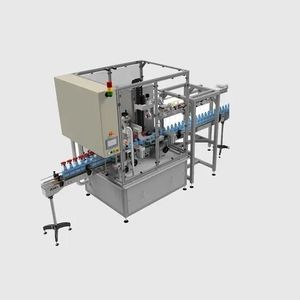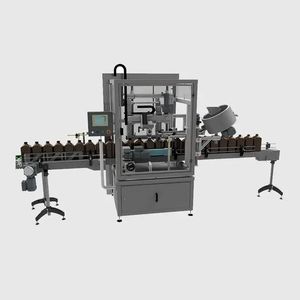
- Laboratory
- Sample management
- Bottle capping system
- Albertina Machinery
Bottle capping system CAPLINE ROTrotarypressure

Add to favorites
Compare this product
Characteristics
- Product applications
- bottle
- Operation
- rotary, pressure
Description
Rotary capping machines are intended for capping various types of containers with screw, pressure and twist-off caps.
Rotary machines are mainly used to close smaller containers and for the closing of special caps (for example, caps with shallow threads). The containers are moved from the conveyor to a step-by-step carusel table, then under the capping head, where the cap is placed using a pick-and-place mechanism into the capping head. Then the container is closed.
The maximum capacity of the single-headed machine is 2,600 bottles/hour.
Continual multi-headed rotary machines are used if larger amounts of bottles are to be closed. Three-heads machines have a capacity of 4,000 bottles per hour, four heads for 6,000 bottles per hour.
After separation of the bottles by timming screw entry, the bottles are passed into the entry carousel and led to the central carousel, where the bottles are being capped while moving. The capping heads are moved together with the closed bottle.
After capping, the bottles are transported by an exit carousel to the exit conveyor.
Motorized conveyor with adjustable speed
Starwheel for transfering bottles
Sensor for detecting container in the starwheel
Rotating cap orientator at the top of the device
Caps chute with sensor to detect cap presence
Pick and Place device
Capping head with adjustable torque
Sensor to detect full outfeed conveyor
Control panel with touch screen
CE safety guards
Caps elevator with hopper
Infeed side belts for stablizitaion of container
Sensor for detecting caps presence
Disposal of bottles without cap
Cap orientator located behind the device
ATEX configuration
Chemical proof configuration
Remote connection
VIDEO
Catalogs
No catalogs are available for this product.
See all of Albertina Machinery‘s catalogs*Prices are pre-tax. They exclude delivery charges and customs duties and do not include additional charges for installation or activation options. Prices are indicative only and may vary by country, with changes to the cost of raw materials and exchange rates.




